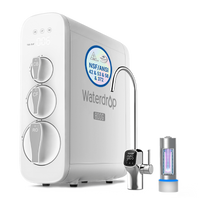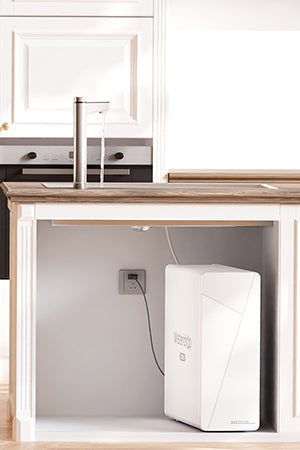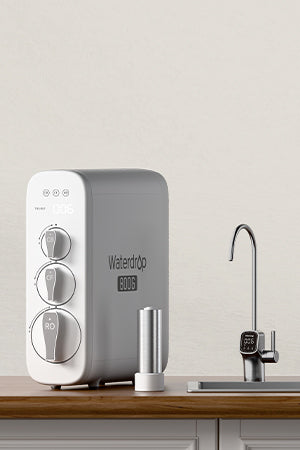The creation of club soda does not need the introduction of carbon dioxide into the
water; instead, it requires the natural generation of carbon dioxide.
It is possible to make pure club soda by combining purified water with baking soda,
also called
sodium
bicarbonate , in the scientific community. The addition of extra carbon dioxide does not need the use of
equipment that generates instantaneous and intense pressure. Baking soda and water that has been purified may be
combined to produce soda. If you want to brew your club soda, the flavor will be improved by using water of a
higher grade filtered via
a reverse osmosis filter . To a greater extent than other sweet beverages,
club soda often has fewer calories.
We see a noticeably considerable number of gaseous carbon dioxide bubbles
developing in the soda after adding sodium bicarbonate to the mixture. However, when the water is heated to
average temperature and pressure, the carbon dioxide bubbles in the water soon break, and the club soda is
rebottled as a standard beverage without sparkling components.
Club Soda’s History
Over the 18th century, humans began to duplicate naturally existing mineral waters
due to breakthroughs in chemistry and industry. In the beginning, an increased amount of naturally existing
carbonic acid gas-containing mineral-rich water was consumed by humans because of its distinctive flavor and the
purported health benefits it offered.
An English scientist,
Joseph Priestley , invented carbonated drinks in 1772 when he discovered how
to add carbon dioxide to water. This was the beginning of the human development of carbonated beverages. Later
on, Johann Jacob Schweppe, the other British citizen, was successful in the commercial manufacturing of
carbonated beverages.
A significant amount of carbonated water was manufactured on a massive scale
throughout the 19th century due to the Industrial Revolution. As a drink and as a mixture of alcoholic drinks,
the carbonated beverage was used in both of these capacities.
Later in the 19th century and at the start of the 20th century, corporations like
Joseph Priestley started
manufacturing and distributing carbonated drinks in various flavors, including bland club soda. This marked the
birth of the soft drink industry, which began to take form during this period.
At the beginning of the twentieth century, the widespread utilization of gas in
cylinders and the development of refrigeration technology created an environment more conducive to commercial
manufacturing. It was common practice for pubs and restaurants to serve club soda as a beverage.
Within the latter half of the 20th century, there was a rise in health awareness
and concerns over the use of sugar-filled beverages. This led to the popularity of sugar-free club soda as an
alternative.
In the twenty-first century, the growth of the restaurant and overseas sectors
contributed to the widespread popularity of club soda. As a result, club soda gradually became a basis for
cocktails that were consumed all over the world.
As a result of successive marketing and promotion efforts, the beverage enjoyed a
greater level of popularity, and it is currently among the standard beverages that drink the most often on the
international market.
It is becoming more common to find club soda in the beverage cabinets of homes, and
it is also becoming a vital beverage option at pubs and restaurants. Along with its extensive use in drinks that
do not include alcohol, club soda has also become deeply established in the culture of modern cuisine.
Various Carbonated Water Types
If you pour several types of sodas into separate glasses and place them in a row,
you will see a slight variation between seltzer, soda water, club soda, and tonic water. On the other hand, one
thing can be said with absolute certainty: the flavor and the process of creating these fizzy waters are
distinct.
These four kinds of carbonated water are all low-calorie solutions, although their
flavors and compositions differ. The choice of each variety is determined by the individual’s tastes and the
planned use, which may include mixing or drinking on a more casual basis. When we understand their differences
better, we will be better able to make an educated choice about when to acquire them.
Club Soda vs Tonic Water
The exact process accomplishes the production of bubbles in club soda and tonic
water, introducing carbon dioxide (CO2) into the water consumed. The bubbles do not differentiate tonic water
from club soda; the additional components and flavors do the trick.
Club soda has a flavor that is somewhat salty and is otherwise relatively clean.
This flavor is achieved with baking soda, sodium citrate, and several minerals. It can be consumed in its purest
form, as the name suggests, but it is also excellent for blending.
The manufacturing process for tonic water includes the addition of quinine, which
is one of the tonic water ingredients. Quinine is a drug that was first used to treat malaria. Its mechanism of
action involves suppressing the parasite that causes malaria, the
Plasmodium
falciparum parasite. This is because quinine has a characteristic bitter flavor, giving tonic water a
bitter taste than other sparkling drinks. Sweeteners such as corn syrup with high fructose content or sugar are
sometimes added to improve the ingredients’ flavor. Therefore, the calories in tonic water are more than those
in other beverages.
The only thing tonic water and other bubbling beverages have in common is the
bubbles they contain. Even though it is tonic water, it would be more correct to define it as a carbonated drink
with quinine and sugar flavors. This assessment would be more accurate. It should be no surprise that the
classic mix of
gin and
tonic is the most delightful combo.
Club Soda vs Sparkling Water
Both sparkling water and club soda may be carbonated by the process of infusing
carbon dioxide gas into containers. On the other hand, sparkling water places a greater emphasis on minerals and
bubbles derived from natural sources, in contrast to club soda, which often contains artificial minerals to
simulate the flavor of natural water that contains minerals.
Club soda often includes a little salt, giving it a somewhat salty flavor. This is
in contrast to sparkling water, which is produced mainly by adding carbon dioxide to ordinary water, giving it a
flavor comparable to that of spring water from nature but with a similar impression of bubbles.
Because of its mildly salted flavor, club soda is frequently employed as a base in
cocktails or other drinks. This is because club soda enhances and balances the flavor of mixed drinks. On the
other hand, bubbling water is frequently consumed on its own as a free of calories, alcohol-free refresher, or
as a base for mixing juices from fruits or creating non-alcoholic cocktails, as is the case with many
sparkling water brands .
Club Soda vs Seltzer Water
Many components that make up club soda and carbonated water are the same. The
flavor of seltzer water is fresher or more neutral than that of club soda since it does not include any extra
salts or minerals. This is the difference between the two beverages.
Because of its slightly salty taste, club soda is a popular choice among specific
individuals for adding a touch of additional flavor to cocktails and other beverages. Some individuals, on the
other hand, like the taste of seltzer water, which is neutral, and they consume it either directly from the
bottle or in beverages when they do not wish to add any additional flavor additives.
Additionally, to generate a variety of flavors, seltzer may sometimes contain
several other natural taste components. You may use either one to give a meal a frothy texture or to produce a
beverage that does not include sugar while cooking.
Club Soda vs Soda Water
Many wonder, “
Is soda water the same as club soda ?” However, the term “soda water” may
also refer to a product produced by bubbling mineral water. In general, “soda water” refers to unflavored water
with carbonated bubbles without any other components. Through the use of club soda, it is possible to blend the
two to produce an equally effective cocktail.
Is Carbonated Water Good for You?
In today’s world, there is a widespread misunderstanding that carbonated water is
the same as cola and contributes to poor health. Consuming carbonated water has several positive effects on
one’s health.
Enhance Proper Hydration
Carbonated water is most often used for hydration. Not only does it satisfy our
thirst, but it also can restore the
electrolytes in our bodies and provide us with water. After a prolonged
period of intensive activity or exposure to extreme temperatures, drinking soda may assist your body in rapidly
restoring its water and energy reserves, minimizing weariness and dehydration. These benefits can be achieved by
drinking soda. Hydration is especially important during certain seasons .
In addition to being drunk with a broad range of other beverages, it is widely used
as a substitute for water. This makes it easier for those who do not like drinking water to get water and
improves their willingness to drink it.
Maintain pH Equilibrium
In addition to this, it could help the body keep its pH balance in check. Even
though our bodies are required to have a certain acid-base balance, many individuals have acidic pH levels due
to the decisions they make about their food and lifestyle. The carbonate content can neutralize the acid in the
body, which helps maintain the body’s acid-base balance. Maintaining the acid-base balance also can prevent some
illnesses, which is essential to our health.
To facilitate digestion
Constipation and dyspepsia are both soothed by drinking carbonated water. It can
neutralize stomach acid, which is beneficial for stomach feeding; it can diminish the stimulating impact of
gastric acid; it can protect the stomach in various ways; it can maintain the acid-base balance of the body; it
may improve gastrointestinal digestion; and it can stimulate intestinal peristalsis.
Is Carbonated Water Bad for You?
Numerous individuals take pleasure in the invigorating flavor of carbonated water.
The flip side of the coin is that drinking to excess could be detrimental to your health. Even taking into
account these potential benefits, drinking an excessive amount of carbonated water might be a source of
discomfort.
Deterioration of the Teeth
The carbonic acid found in carbonated water has the potential to increase the
beverage’s acidity. Consuming an excessive amount of acidic drinks may have adverse consequences on teeth,
including the demineralization of dental enamel, an increase in the risk of dental cavities, and the development
of decaying teeth and sensitivity. However, carbonated water that does not include sugar is far less hazardous
to one’s health than carbonated drinks that contain sugar. Carbonated water that does not include any added
sugar or flavorings is a less unhealthy alternative.
Diabetes, as well as obesity
Certain carbonated drinks contain a significant amount of sugar. Consuming an
excessive amount of sugar may lead to issues with the body in a variety of different ways. In the first place,
sugar is a rapid source of energy. When it does not get used up fast, it accumulates in the body, which leads to
a rise in body weight and even has the potential to cause obesity. Consuming excessive sugar may cause large
swings in the level of blood sugar and can also upset the homeostasis of blood sugar levels throughout the body.
High blood sugar fluctuations that last for an extended period may result in long-term chronic illnesses such as
diabetes.
Bloating and Gas
Carbonated water is mainly composed of carbon dioxide, the primary component. Our
bodies will make carbonate ions by absorbing the carbon dioxide when we consume it. An excessive amount of
carbonate ions will drive the stomach to produce more acid, which will distress the stomach and ultimately lead
to an excessive amount of acid produced by the stomach. In addition to gastritis and gastric ulcers, the
drinking of high quantities of soda over an extended period may also contribute to the occurrence of
other stomach disorders .














































































